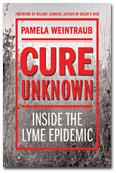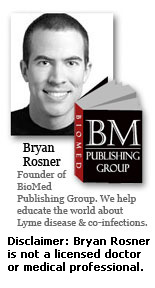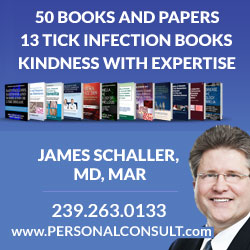Cure Unknown by Pamela Weintraub NEW BOOK
By Bryan Rosner on Aug 7, 2008 in General News
 This new book by Pamela Weintraub really is excellent. I do not feel it duplicates any of the other information available in other Lyme disease books, so it is a must-read. Click here to order it. Keep reading to view the foreword for the book written by Hillary Johnson. Or, learn more about the book and read other excerpts here.
This new book by Pamela Weintraub really is excellent. I do not feel it duplicates any of the other information available in other Lyme disease books, so it is a must-read. Click here to order it. Keep reading to view the foreword for the book written by Hillary Johnson. Or, learn more about the book and read other excerpts here.
Foreword by Hillary Johnson, author of Osler’s Web
In 1993, journalist Pamela Weintraub and her husband thought they were doing themselves and their two sons a favor by escaping from Queens to the sylvan New York suburb of Chappaqua, a town so famously bucolic Bill and Hillary Clinton made it their outpost after decamping from the White House. In time, however, the deer-friendly backyard where Weintraub’s sons spent lazy afternoons building forts turned into the author’s personal Love Canal. Tragedy lurked under every fallen leaf. Both her sons eventually contracted tick-borne Lyme disease, as did she and her husband. Their suffering dragged on for years.
The conventional dogma about Lyme disease, according to Allen Steere, the doctor who was the first to describe it in 1977, holds that a one-time course of antibiotics is almost always entirely curative. But Weintraub quickly discovered that little about Lyme disease was as straightforward as Steere and his supporters in the public health establishment claimed. The tests used to diagnose a case of Lyme turned out to be primitive, sometimes wildly inaccurate or, at best, unreliable. In addition, the official diagnostic criteria handed down from on high by the Centers for Disease Control and Prevention failed to apply to many if not most patients who the doctors in heavily endemic regions actually saw in their practices.
Instead, as Weintraub discovered, the disease was both a masquerader and a changeling, not unlike another spirochete-induced disease, syphilis, in which overtly neurological symptoms emerged over time such that they were not always understood to be related to the initiating infection—in the case of Lyme, spirochetes transmitted by a tick bite. In fact, as Weintraub was to learn, “chronic” Lyme disease was a neurological time bomb that, once established in the body, could lead to a host of devastating results from near-crippling exhaustion and nerve pain to memory loss, confusion, and, at its most extreme, a kind of Lyme dementia.
As the years of Weintraub’s illness wore on, the quarrels among doctors, scientists, and public health officials became only more bitter and dogmatic, until the mainstream power brokers in medicine seemed to dump chronic Lyme sufferers into a Bermuda Triangle of diseases. Nowhere is the view of chronic Lyme more hardened and, as Weintraub argues persuasively, unenlightened than in the highest reaches of the federal science establishment. Indeed, as recently as 2006, the federal government endorsed a document stating categorically that chronic Lyme doesn’t exist.
To prepare readers for the bumpy ride, Weintraub creates a rich topographical as well as intellectual framework for her, at times, jaw-dropping tale of doctors and scientists behaving badly: the land of Lyme. We are nowhere near the Congo villages of Ebola fame, but, seemingly as dangerous, the backyard savannahs, as Weintraub describes them, of suburban “soccer moms” and “soccer dads” who dwell in false harmony with flourishing deer populations rife with Ixodes ticks carrying Borrelia burgdorferi, the Lyme spirochete, as well as pathogens causing babesiosis, anaplasmosis, and other infectious diseases in their tiny mouths and guts. Deer lovers stand forewarned: In this author’s hands, Bambi just ain’t Bambi anymore, but then, that’s one of Weintraub’s strengths— she takes no prisoners.
Weintraub’s journalistic bonafides are impeccable. She’s a reporter with twenty-five years of science journalism and editing under her belt, a credential buttressed by solid academic training in her field and apprenticeships with important scientists. Those credits are on full display in this narrative. I suspect, however, that when the nuances of Lyme disease science bumped up against medical dogma that seemed increasingly inapplicable to her own experience of the disease, she must have felt as though she had fallen through the looking glass.
The very people she once might have sought out for definitive quotes on the subject had become unreliable; the scientific literature was increasingly difficult to trust, as well. The more Weintraub investigated, the more virtually everyone with a shred of authority was losing their credibility, from the nation’s “expert” on Lyme disease, Steere, to the psychologist at the Horace Greeley High School, who advised her to get her son a good haircut instead of nurturing his fantasy that he was too ill to attend school. As Weintraub would see it firsthand, the so-called “objective” scientists were sending an entire disease down the river and over a cliff for reasons that seemed frequently to have more to do with mere opinion and crass external forces—cash, prestige, careerism—than with scientific erudition.
Happily, Weintraub did not retire to her Victorian fainting couch for the duration, a choice some of the academicians she writes about in Cure Unknown surely will rue (and not merely because she was ignoring their recommended therapy for what ailed her). She appears to have tracked down every lead and reached out to everyone with something intelligent to say about this devastating malady. She rejected the science writer’s inbred habit of relying on the government official with the highest pay grade or the scientist with a job at Harvard as the final word on a topic. Instead, she developed a healthy skepticism for the assertions of those doctors whose cozy relationships with the National Institutes of Health or the New England Journal of Medicine—not to mention flourishing sidelines as consultants to insurance companies and big pharma— provided them with unchallenged hegemony in the field. In Weintraub’s hands, they emerge less as experts than as representatives of the myriad chronic deficiencies in our national defense system against infectious disease. She gives the power brokers their say but then she goes deeper, searching for open minds, not closed ones. When she found them, she gave them her full attention. I think of her, with enormous respect, as a “recovered” science journalist.
The result of her tenacity is Cure Unknown,the first major journalistic examination of the Lyme wars and a book solidly in the tradition of the late journalist Randy Shilts’s 1987 book, And the Band Played On: People, Politics, and the AIDS Epidemic,as well as my own 1996 book, Osler’s Web: Inside the Labyrinth of the Chronic Fatigue Syndrome Epidemic.Both of those earlier books opened a wide door onto the dangerous and often outrageous phenomenon of doctors, scientists, and federal officials dismissing as folly major emerging diseases. Weintraub follows suit with her impressive contribution to that so-far unique body of literature, offering the third in what is now a trilogy of aggressive investigations into the willfully unchecked spread of infectious diseases in this country.
I wasn’t overly surprised by Weintraub’s tale, but I was fascinated— in the mournful way one is fascinated by disasters with shocking casualty numbers—by the fact that it had happened again. Most compelling to me, as someone who wrote a book about another disease that was dispatched to the back of the bus in the 1980s, is the clarity with which Weintraub addresses a system of disease surveillance and investigation in this country that is broken in so many ways. She nails the worst of it when she writes near the conclusion of Cure Unknown,”[E]xperts have imposed a rigid template on an entity they don’t fully understand. Because their studies flow from the disease definition, rather than the other way around, they have generated information about a ‘disease model’ but not the disease itself.”
Indeed, when a handful of academic clinicians and federal officials cobble together by show of hands, or a jocular exchange of snail-mail as occurred with “chronic fatigue syndrome,” a Chinese menu–style definition of a disease about which they know little, if anything, it is madness, not science. Instead of fostering serious investigation, such definitions spur myth, speculation, and a kind of Tower of Babel confusion from which only scientific errors and misperceptions may flow, possibly for generations. It’s no wonder chronic Lyme, chronic fatigue syndrome, Gulf War syndrome, along with several other diseases, tend to be slopped together as if interchangeable. The consensus definitions contrived by federal officials are paradoxically too vague and overly rigid, frequently emphasizing unimportant aspects and putting little stock, if any, in the most salient, distinctive characteristics of each disease.
If it wasn’t apparent before, the publication of Cure Unknown makes it abundantly clear that we are living in an era of “contested” diseases. In this troubling, even tragic era, people are sick, disabled, and dying from illnesses that the premier authorities in establishment medicine proclaim do not exist as discrete pathological entities but are, instead, a figment of the patient’s overactive imagination. All sorts of contorted linguistic anomalies have arisen from the field of contested diseases in the last two decades. Phrases like “medically unexplained symptoms,” shorthanded in medical journal articles to “MUPS,” “somatoform disorder,” “illness attribution,” and “sickness behavior” are tossed around as if they have a real grounding in medical science by doctors and especially by psychiatrists, who are having a field day in this new era. These phrases are code for more familiar words like “hysteria,” “hypochondria,” and “mental illness,” phrases doctors prefer not to write in patients’ charts. When these illnesses occur in children, doctors often train their antennae on the parents, who may then be accused of another equally dubious and damning condition known as Munchausen Syndrome by Proxy, said to afflict parents who induce illness in their own children in order to attract attention to themselves. If the parents escape suspicion, the child in- evitably bears the brunt, like the wheelchair-bound boy in England suffering from “chronic fatigue syndrome” (or, as that disease is more accurately known in the UK, myalgic encephalomyelitis) who was tossed into a swimming pool by a psychiatrist on the hypothesis that he would find the strength to swim if his life was at stake. The child was fished out before he drowned.
It sometimes seems as if the remarkable technological and scientific advances of the last half century have served to create a medical dead zone in which these contested diseases must languish because the science is still being worked out. Scientists can reconstruct extinct viruses from microscopic fragments retrieved from long-dead corpses; the human genome has been decoded. Yet, a side effect has been that many scientists and doctors—the latter of whom are trained to look for horses, not zebras, after all—can no longer allow uncertainty and ambiguity to coexist with scientific fact. This seems to be true even as the science has increasingly resolved the ambiguities and the zebras have emerged as the dominant quadruped in the herd.
The ancient and formerly revered scientific rule known as Occam’s razor, which holds that the simplest explanation is probably the correct ex- planation, has no credence in the Brave New World of contested diseases. Common logic, anecdotal evidence, and on-the-ground clinical observations—by which I mean the simple process of doctors listening to and thinking about what their patients are telling them—are held in disregard by the most powerful players in the research establishment. These power players include pious academicians who have little or no contact with patients who suffer from these maladies, yet form opinions and theories about them that carry far more weight in the medical com- munity than is scientifically warranted. They reduce science to theology, changing the essential question from “What does the data say?” to “Do you believein this disease or do you not?”
They include, as well, medical journal editors who function as gatekeepers of information. Time and again, these editors open their doors wide to putative experts on a particular contested disease because the authors hold high posts in academia or are working under the aegis of federal health agencies like the Centers for Disease Control and Prevention or the National Institutes of Health. In a manner reminiscent of bigoted, stuffy gentlemen’s clubs, however, these journals bar their doors to investigators who have actually performed legitimate scientific re- search in the field but cannot get the requisite traction with the academics and the government because such findings and even their hypotheses run counter to prevailing theory; that is, they are approaching the dis- ease as if its existence is not contested. As a result, their findings are ushered to obscure journals or go unpublished altogether. Progress toward clarifying the disease process, its cause, or, best of all, resolution of a contested disease is inhibited.
One result is that the dreams of researchers who could be helpful to theprocess are smashed when, year after year, the government rejects their proposals to study the disease. Another is that doctors who want to help their patients with novel drug regimens become too intimidated toeven try for fear of reprisals by state medical boards.
These are hardly cordial disagreements. Bodies are strewn every- where and, for the moment, I am not referring to the afflicted but to the healthy. As Weintraub describes the carnage, doctors shutter their practices and move to distant states; humiliated researchers forswear their in- terests and retreat into less controversial fields. After the publication of my book, which revealed that scientists at the Centers for Disease Control had created a secret CFS slush fund to misappropriate millions of taxpayer dollars earmarked by Congress for CFS research, the head of the agency resigned and scientists were reassigned—though none fired— depending on which side of the issue they fell. On the matter of contested diseases, public health employees generally raise their fingers to the wind to see which way it’s blowing and act accordingly.
Aiding and abetting these power players, if unwittingly, are reporters whose
job it is to relay new developments in science and medicine to readers but in doing so rarely step outside the box to solicit interviews with researchers whose work runs counter to the conventional wisdom of federal scientists. In their desire to be “scientifically accurate” or adhere to the much-vaunted journalistic ethic of objectivity, they become stenographers, mistakenly assuming the summary answer to any scientific dilemma can be resolved with a conversation with some government employee in the cinder-block offices of the Centers for Disease Control in Atlanta or on the manicured campus of the National Institutes of Health in Bethesda.
Much like the influential medical journal articles read by doctors in private practice, the mainstream stories that result from such encounters are equally benighted and misleading. They serve to buttress the authority of the “experts” and bring further infamy upon the heads of patients, who tend to be portrayed as people who believe they are ill and—in our P.C. world—therefore worthy of sympathy, but whose maladies have no apparent basis in reality.
In my experience, the last thing patients are seeking is sympathy. What they want instead, quite desperately, is biomedical research. They’re often referred to as “stakeholders” by government agencies, as if simply calling them what they actually are, sick people, threatens the established order. In describing what she calls the “Sartre-esque” world of the Lyme- afflicted, Weintraub notes that, often, only the richest and best connected of patients—a “made person,” who, for instance, writes books about the (contested) disease or is a leader of a patient organization with access to the rare doctor who will help—actually receive the truly comprehensive treatments required to restore them to health. Even then, help is dicey, with doctors ditching their practices due to burnout or intimidation. Insurance companies, not surprisingly, are off the hook. After all, if the New England Journal of Medicine publishes an article insisting the antibiotic treatment for Lyme disease need not exceed, say, ten days, why should any of the profit-oriented mega-corporations selling insurance policies act in ways that contradict the conclusions of the most venerable medical journal in the world?
Sir William Osler, a clinician of the early 1900s, revered for his clinical acumen, wrote that studying medicine without patients was like going to sea without charts. And yet, that is the cardinal medical sin scientists at the federal agencies and the upper echelons of academia commit in the realm of contested diseases, hiding behind the mantle of “objectivity.” When the patients refuse to go away or renounce their “sickness behavior,” these scientists convene at the CDC or the NIH to hammer out successive definitions of contested diseases. When their bylines appear at the top of a journal article, the endless feedback loop that props up the system once again anoints them masters of the field despite their being wholly removed from the lowly office encounter between doctor and patient and pathetically unschooled in the entity that has brought that patient figuratively, and sometimes literally, to his knees. In short, they reduce the practice of science to the level of engineering or, perhaps, accounting.
Certainly, medical history is one of myriad cycles of disbelief followed by the begrudging acceptance of scientific truths. In that history, scientific facts long considered heresy are ultimately embraced, but only when the highest authorities in the land get on board, a process that sometimes takes generations. Throughout the last century, for instance, neurological diseases, which have been short on infectious causes, so far, but long on symptoms, have been targets of disbelief. In the early 1900s, multiple sclerosis was known as the “faker’s disease.” New technolo- gies, such as the debut in 1985 of magnetic resonance imaging, which visualized lesions in the brains of MS sufferers, also have helped to legitimize diseases like Parkinson’s, ALS, and Alzheimer’s. But I suspect this particular era will go down in medical history as one of the most contentious. In part, there is the legacy of the 1950s toblame, when, after the development of penicillin drugs, the medical establishment fell into the relaxed stance that infectious diseases had been or soon would be conquered. A bigger problem is that technology itself has removed the workaday doctor in his or her clinic from extended interaction with patients. Economic issues are paramount. Doctors listen to patients long enough to decide which tests to order and the patient is sent packing. But what if the patient is suffering from some- thing for which a test has not been invented or the tests are notoriously unreliable or outdated? When there is a new or emerging disease on the horizon, or right before the doctor’s nose, he or she is virtually guaranteed to miss it.
At the moment, even the bedrock discoveries provided by new technologies have not seemed to move the science of contested diseases forward. Weintraub describes in fascinating detail the leaps in understanding the pathogens that can cause chronic Lyme infections to smolder for decades in the body and the increasingly sophisticated, if still experimental, assays that could be marshalled to test for them, as well as antibiotic therapies that comprise a growing armamentarium to keep these infections at bay.
But, in chronic Lyme, as in other contested diseases, the naysayers at the top of the food chain continue to win the day by shouting down the individual researcher who has made the discoveries. It’s particularly easy for those at the top of the scientific heap—such as administrators at the NIH, the CDC, and elite medical schools, as well as journal editors—to silence entire populations of sick people by suggesting patients are malingerers or too wimpy to handle stress when they broadcast their opinions to the mainstream media from their bully pulpits.
It’s not only highly placed scientists who determine which disease gets disappeared and which is deemed important and “real.” Patent rights that encourage academic researchers to withhold discoveries from public scrutiny for years at a time and internecine politics inside federal health agencies, by which I mean jockeying for hegemony and job security, play a role, too.
The tragedy of contested diseases stems not from any conspiracy on the ground, as Weintraub, who has had years to contemplate the mat- ter, points out. Instead, these tragedies result from a “perfect storm,” as she describes it, of flawed science, medical hubris, and moneyed interests. I agree. Yet, if one pulls back in a wide angle and with hindsight, occasionally the word conspiracy does seem broadly applicable. While I was working on Osler’s Web, I became friends with a highly respected cancer epidemiologist who sought NIH funding for research in the CFS field and failed, though he routinely received millions of dollars in NIH funding for other diseases. He commented that the tide would turn in chronic fatigue syndrome only when a pathogenic agent was discovered. He added, “Then we will see what was in essence a conspiracy by very rigid people who didn’t have the imagination to believe this disease exists. They didn’t decideto do this. It wasn’t a bunch of people sitting around a table. It’s been institutional sabotage in the broadest sense.”
As one of Weintraub’s least hubristic scientists notes near the end of Cure Unknown, “Some researchers have thrown down their gloves and retreated to their corners, leaving patients out in the cold. But…it’s not a question of whether you might have to eat crow. We’ve got to go in and do the right experiments, and then we can look truth in the eye.” The problem is, too many of the power brokers in the medical establishment who launched these faulty definitions and embraced the mantle of “expert” over the ensuing years don’t see it that way. To reverse their positions, to admit they might have been wrong, to open up the grant-making process to investigators who have new approaches and ideas, feels very much like eating crow, and few show signs of changing their stance in the future.
There will be those, including other reporters and editors, who will argue that only scientists in the upper echelons of the most prestigious universities and public health officials of the highest rank are allowed the final word in chronic Lyme. As a longtime journalist and the author of an earlier book about another disease that has been similarly deemed not bona fide, I would argue that it is just such thinking that encourages the kind of disastrous public health policies, with their skewed research agendas, that Weintraub describes.
Further, as one who also suffers from the disease I chronicled with kindred passion in Osler’s Web, I sometimes wonder if the only investigative writers who will possess the necessary temerity to remove the white gloves and tackle these putative experts to the ground will be those, like Weintraub and the late Randy Shilts, whose personal experience demands that they follow the rocky trail that leads to the truth. —Hillary Johnson
Hillary Johnson’s science and environmental reporting has appeared in Rolling Stone, where she was a contributing editor for ten years, as well as Mirabella, Life, Self, and Working Woman. Her original reporting on chronic fatigue syndrome for Rolling Stone in 1988 was nominated for a National Magazine Award. She has been a journalist for thirty years, reporting for national newspapers and magazines such as The Wall Street Journal, Vanity Fair, Vogue, Elle, and GQ. She is the author of two books, Osler’s Web: Inside the Labyrinth of the Chronic Fatigue Syndrome Epidemic and My Mother Ruth: A Memoir of Love, Loss and Art. A tenth-anniversary edition of Osler’s Web, with an update by the author, was recently released.








